Management Accounting Systems: Techniques, Analysis, and Performance
VerifiedAdded on 2024/05/17
|35
|4974
|452
Report
AI Summary
This report explores various management accounting systems used to analyze a company's performance, identifying cost analysis techniques and their application in financial reporting. It explains the benefits of management accounting systems within an organizational context, highlighting the use of planning tools to address financial problems and ensure sustainability. The report includes a marginal costing statement and an absorption costing statement for three years, along with a reconciliation statement to compare the results. It discusses the principles of management accounting, such as profit calculation considering inflation, utility, return on business, and resource utilization. The report also touches on fund flow statement analysis, standard costing, marginal costing techniques, and budgetary control. It concludes that management accounting is crucial for preparing and managing reports, while various accounting systems are responsible for evaluating organizational performance in the external market.
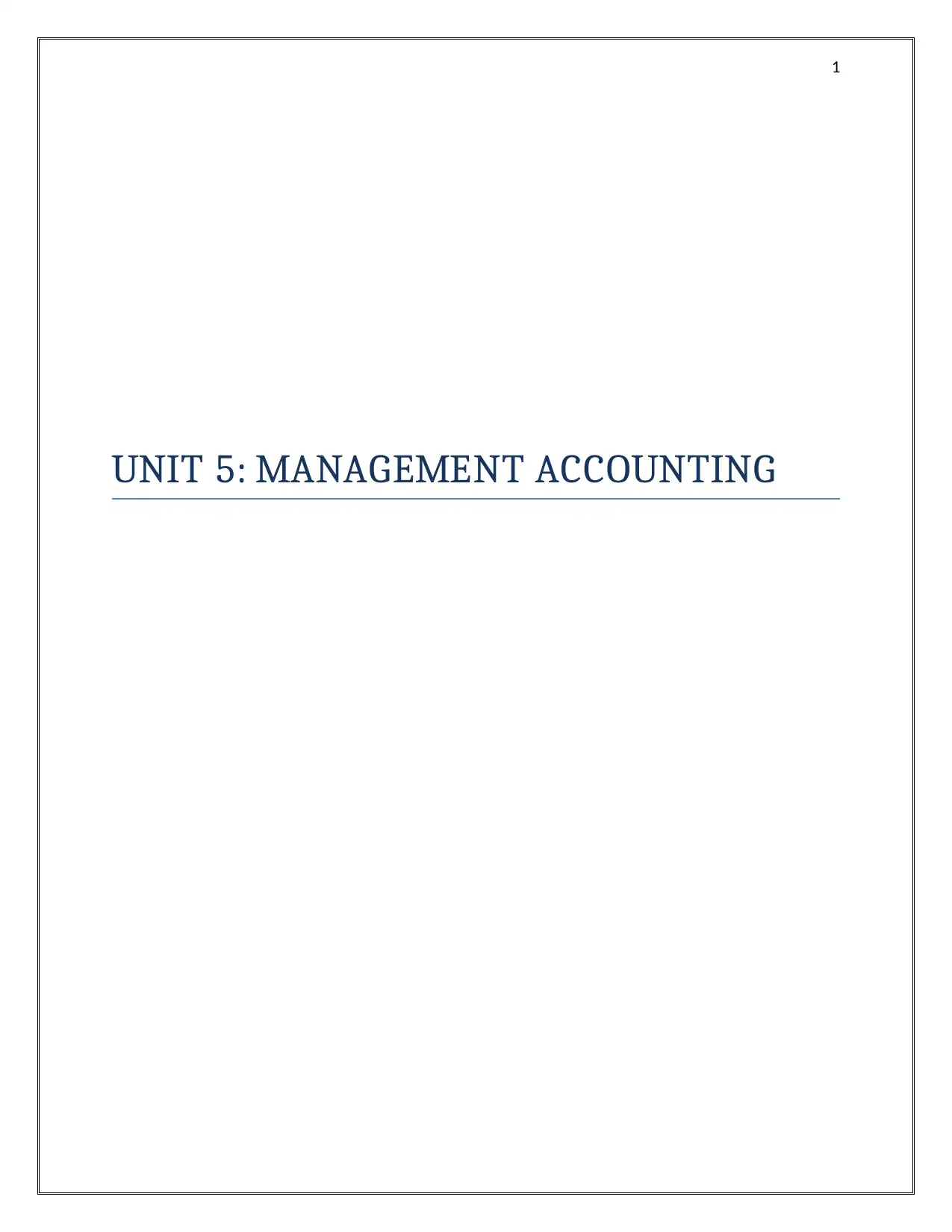
1
UNIT 5: MANAGEMENT ACCOUNTING
UNIT 5: MANAGEMENT ACCOUNTING
Paraphrase This Document
Need a fresh take? Get an instant paraphrase of this document with our AI Paraphraser
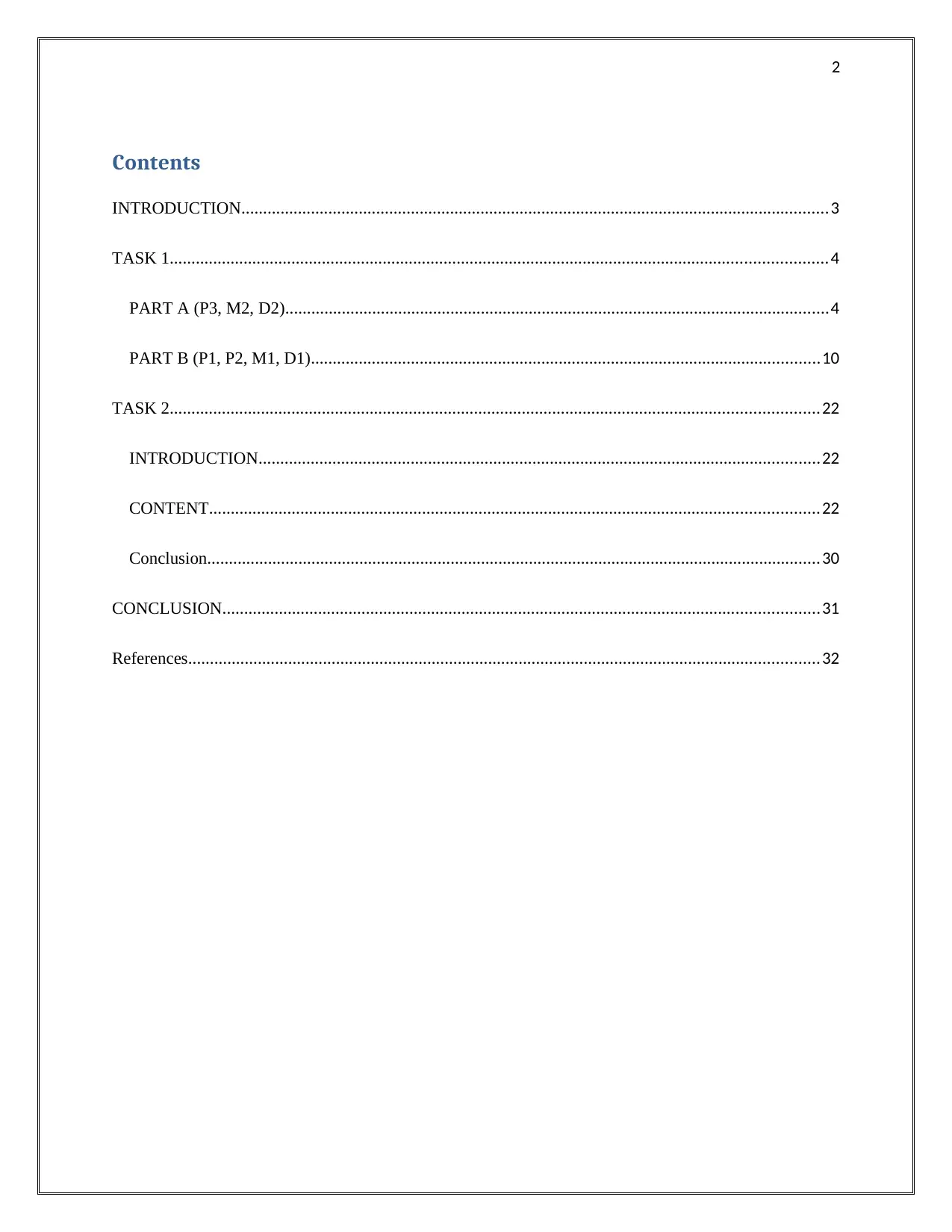
2
Contents
INTRODUCTION.......................................................................................................................................3
TASK 1.......................................................................................................................................................4
PART A (P3, M2, D2).............................................................................................................................4
PART B (P1, P2, M1, D1).....................................................................................................................10
TASK 2.....................................................................................................................................................22
INTRODUCTION.................................................................................................................................22
CONTENT............................................................................................................................................22
Conclusion.............................................................................................................................................30
CONCLUSION.........................................................................................................................................31
References.................................................................................................................................................32
Contents
INTRODUCTION.......................................................................................................................................3
TASK 1.......................................................................................................................................................4
PART A (P3, M2, D2).............................................................................................................................4
PART B (P1, P2, M1, D1).....................................................................................................................10
TASK 2.....................................................................................................................................................22
INTRODUCTION.................................................................................................................................22
CONTENT............................................................................................................................................22
Conclusion.............................................................................................................................................30
CONCLUSION.........................................................................................................................................31
References.................................................................................................................................................32
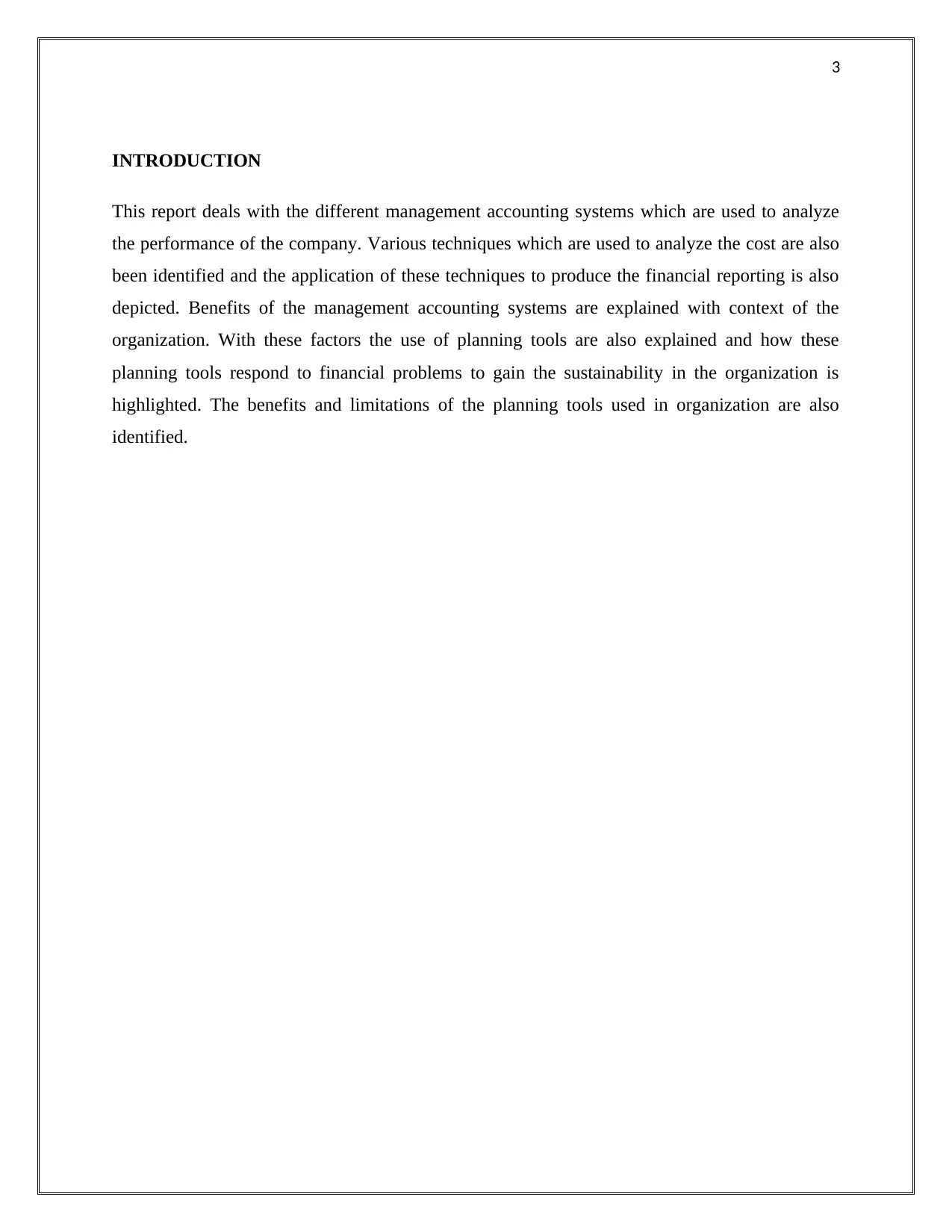
3
INTRODUCTION
This report deals with the different management accounting systems which are used to analyze
the performance of the company. Various techniques which are used to analyze the cost are also
been identified and the application of these techniques to produce the financial reporting is also
depicted. Benefits of the management accounting systems are explained with context of the
organization. With these factors the use of planning tools are also explained and how these
planning tools respond to financial problems to gain the sustainability in the organization is
highlighted. The benefits and limitations of the planning tools used in organization are also
identified.
INTRODUCTION
This report deals with the different management accounting systems which are used to analyze
the performance of the company. Various techniques which are used to analyze the cost are also
been identified and the application of these techniques to produce the financial reporting is also
depicted. Benefits of the management accounting systems are explained with context of the
organization. With these factors the use of planning tools are also explained and how these
planning tools respond to financial problems to gain the sustainability in the organization is
highlighted. The benefits and limitations of the planning tools used in organization are also
identified.
⊘ This is a preview!⊘
Do you want full access?
Subscribe today to unlock all pages.

Trusted by 1+ million students worldwide
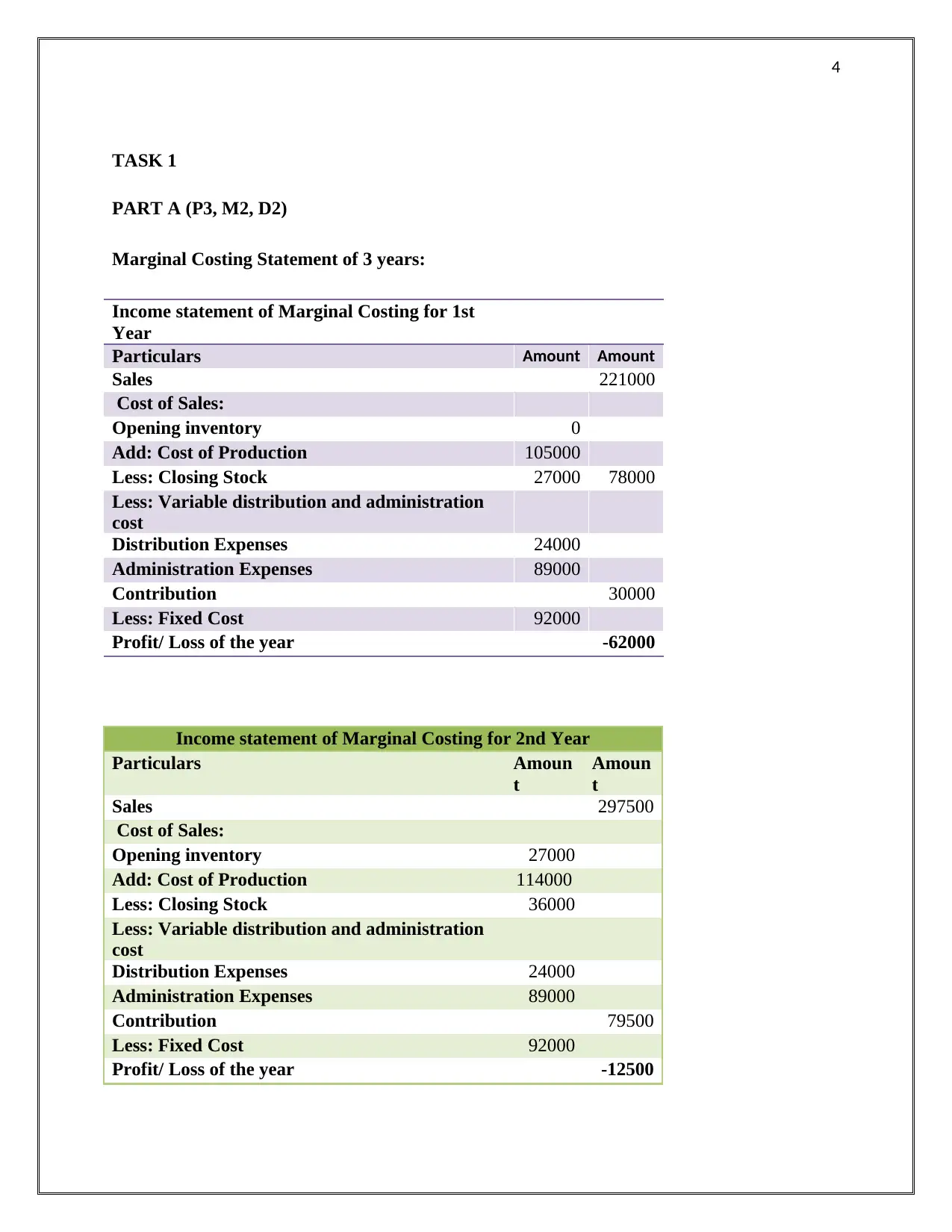
4
TASK 1
PART A (P3, M2, D2)
Marginal Costing Statement of 3 years:
Income statement of Marginal Costing for 1st
Year
Particulars Amount Amount
Sales 221000
Cost of Sales:
Opening inventory 0
Add: Cost of Production 105000
Less: Closing Stock 27000 78000
Less: Variable distribution and administration
cost
Distribution Expenses 24000
Administration Expenses 89000
Contribution 30000
Less: Fixed Cost 92000
Profit/ Loss of the year -62000
Income statement of Marginal Costing for 2nd Year
Particulars Amoun
t
Amoun
t
Sales 297500
Cost of Sales:
Opening inventory 27000
Add: Cost of Production 114000
Less: Closing Stock 36000
Less: Variable distribution and administration
cost
Distribution Expenses 24000
Administration Expenses 89000
Contribution 79500
Less: Fixed Cost 92000
Profit/ Loss of the year -12500
TASK 1
PART A (P3, M2, D2)
Marginal Costing Statement of 3 years:
Income statement of Marginal Costing for 1st
Year
Particulars Amount Amount
Sales 221000
Cost of Sales:
Opening inventory 0
Add: Cost of Production 105000
Less: Closing Stock 27000 78000
Less: Variable distribution and administration
cost
Distribution Expenses 24000
Administration Expenses 89000
Contribution 30000
Less: Fixed Cost 92000
Profit/ Loss of the year -62000
Income statement of Marginal Costing for 2nd Year
Particulars Amoun
t
Amoun
t
Sales 297500
Cost of Sales:
Opening inventory 27000
Add: Cost of Production 114000
Less: Closing Stock 36000
Less: Variable distribution and administration
cost
Distribution Expenses 24000
Administration Expenses 89000
Contribution 79500
Less: Fixed Cost 92000
Profit/ Loss of the year -12500
Paraphrase This Document
Need a fresh take? Get an instant paraphrase of this document with our AI Paraphraser
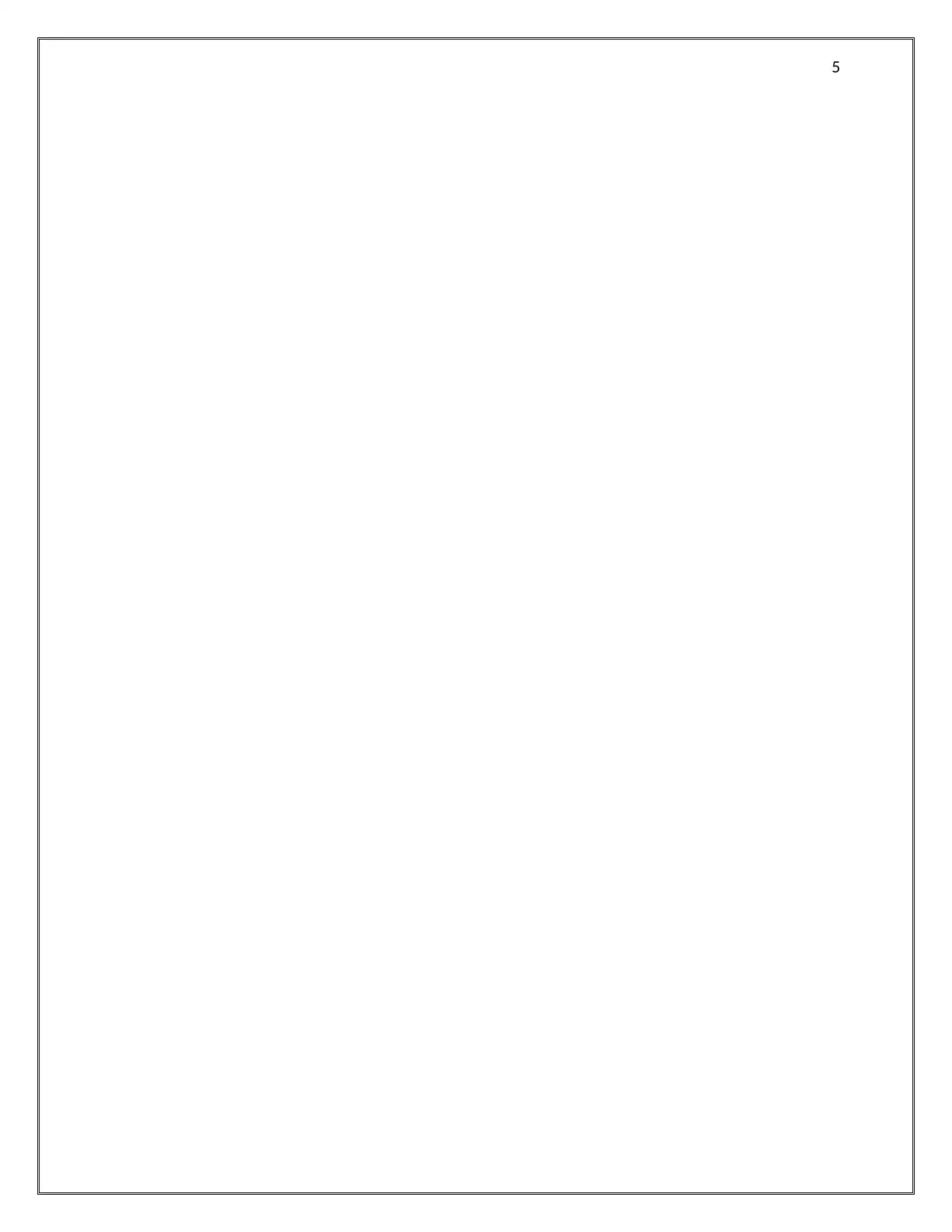
5
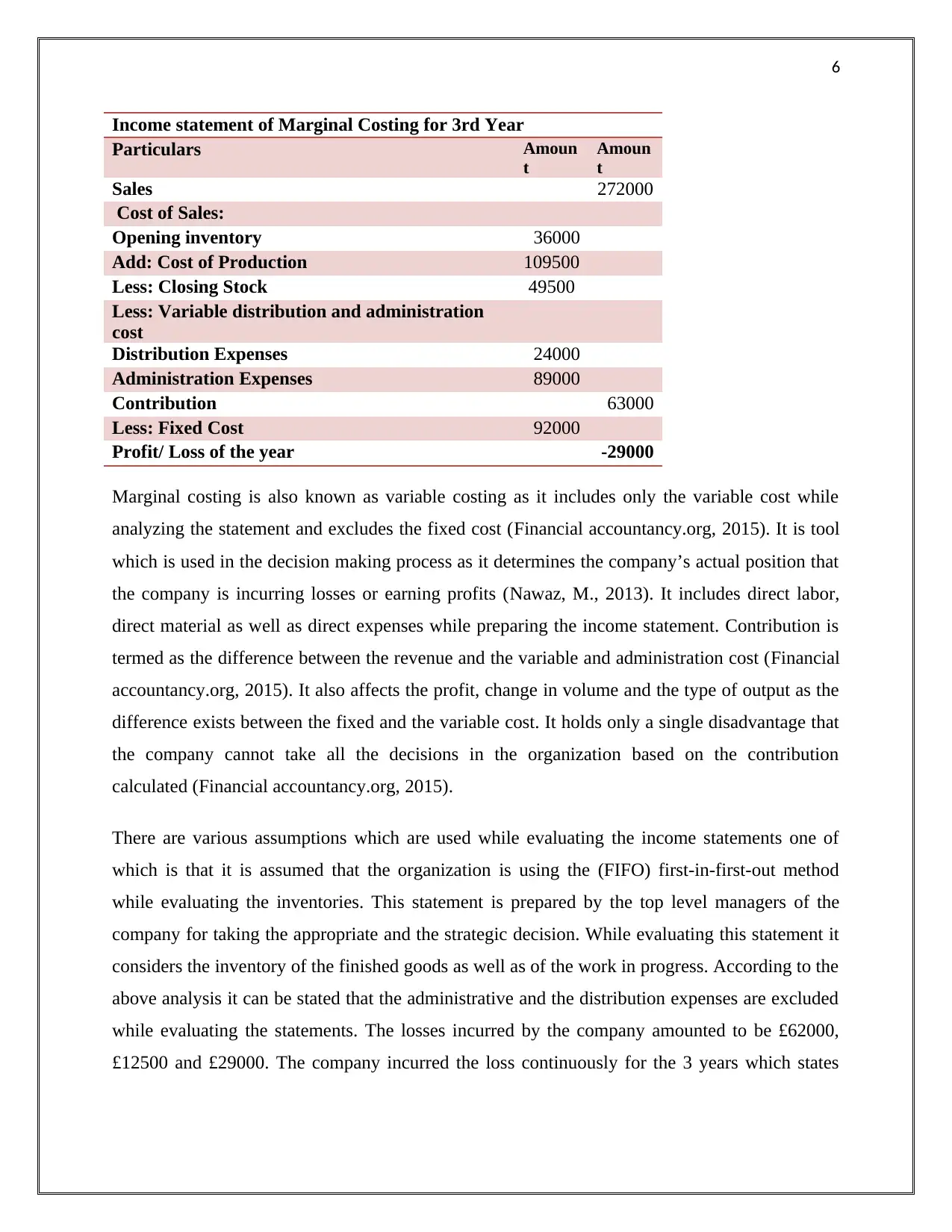
6
Income statement of Marginal Costing for 3rd Year
Particulars Amoun
t
Amoun
t
Sales 272000
Cost of Sales:
Opening inventory 36000
Add: Cost of Production 109500
Less: Closing Stock 49500
Less: Variable distribution and administration
cost
Distribution Expenses 24000
Administration Expenses 89000
Contribution 63000
Less: Fixed Cost 92000
Profit/ Loss of the year -29000
Marginal costing is also known as variable costing as it includes only the variable cost while
analyzing the statement and excludes the fixed cost (Financial accountancy.org, 2015). It is tool
which is used in the decision making process as it determines the company’s actual position that
the company is incurring losses or earning profits (Nawaz, M., 2013). It includes direct labor,
direct material as well as direct expenses while preparing the income statement. Contribution is
termed as the difference between the revenue and the variable and administration cost (Financial
accountancy.org, 2015). It also affects the profit, change in volume and the type of output as the
difference exists between the fixed and the variable cost. It holds only a single disadvantage that
the company cannot take all the decisions in the organization based on the contribution
calculated (Financial accountancy.org, 2015).
There are various assumptions which are used while evaluating the income statements one of
which is that it is assumed that the organization is using the (FIFO) first-in-first-out method
while evaluating the inventories. This statement is prepared by the top level managers of the
company for taking the appropriate and the strategic decision. While evaluating this statement it
considers the inventory of the finished goods as well as of the work in progress. According to the
above analysis it can be stated that the administrative and the distribution expenses are excluded
while evaluating the statements. The losses incurred by the company amounted to be £62000,
£12500 and £29000. The company incurred the loss continuously for the 3 years which states
Income statement of Marginal Costing for 3rd Year
Particulars Amoun
t
Amoun
t
Sales 272000
Cost of Sales:
Opening inventory 36000
Add: Cost of Production 109500
Less: Closing Stock 49500
Less: Variable distribution and administration
cost
Distribution Expenses 24000
Administration Expenses 89000
Contribution 63000
Less: Fixed Cost 92000
Profit/ Loss of the year -29000
Marginal costing is also known as variable costing as it includes only the variable cost while
analyzing the statement and excludes the fixed cost (Financial accountancy.org, 2015). It is tool
which is used in the decision making process as it determines the company’s actual position that
the company is incurring losses or earning profits (Nawaz, M., 2013). It includes direct labor,
direct material as well as direct expenses while preparing the income statement. Contribution is
termed as the difference between the revenue and the variable and administration cost (Financial
accountancy.org, 2015). It also affects the profit, change in volume and the type of output as the
difference exists between the fixed and the variable cost. It holds only a single disadvantage that
the company cannot take all the decisions in the organization based on the contribution
calculated (Financial accountancy.org, 2015).
There are various assumptions which are used while evaluating the income statements one of
which is that it is assumed that the organization is using the (FIFO) first-in-first-out method
while evaluating the inventories. This statement is prepared by the top level managers of the
company for taking the appropriate and the strategic decision. While evaluating this statement it
considers the inventory of the finished goods as well as of the work in progress. According to the
above analysis it can be stated that the administrative and the distribution expenses are excluded
while evaluating the statements. The losses incurred by the company amounted to be £62000,
£12500 and £29000. The company incurred the loss continuously for the 3 years which states
⊘ This is a preview!⊘
Do you want full access?
Subscribe today to unlock all pages.

Trusted by 1+ million students worldwide
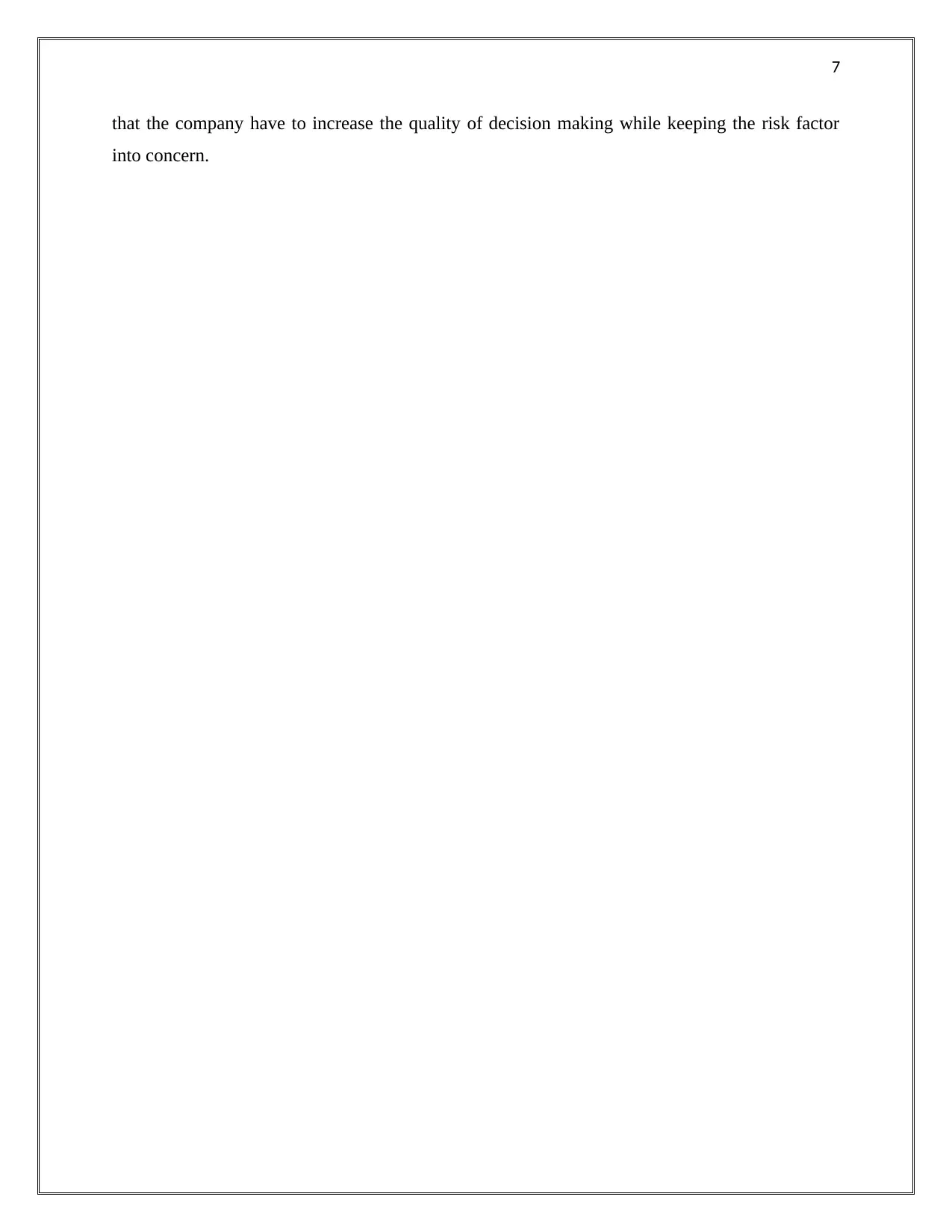
7
that the company have to increase the quality of decision making while keeping the risk factor
into concern.
that the company have to increase the quality of decision making while keeping the risk factor
into concern.
Paraphrase This Document
Need a fresh take? Get an instant paraphrase of this document with our AI Paraphraser
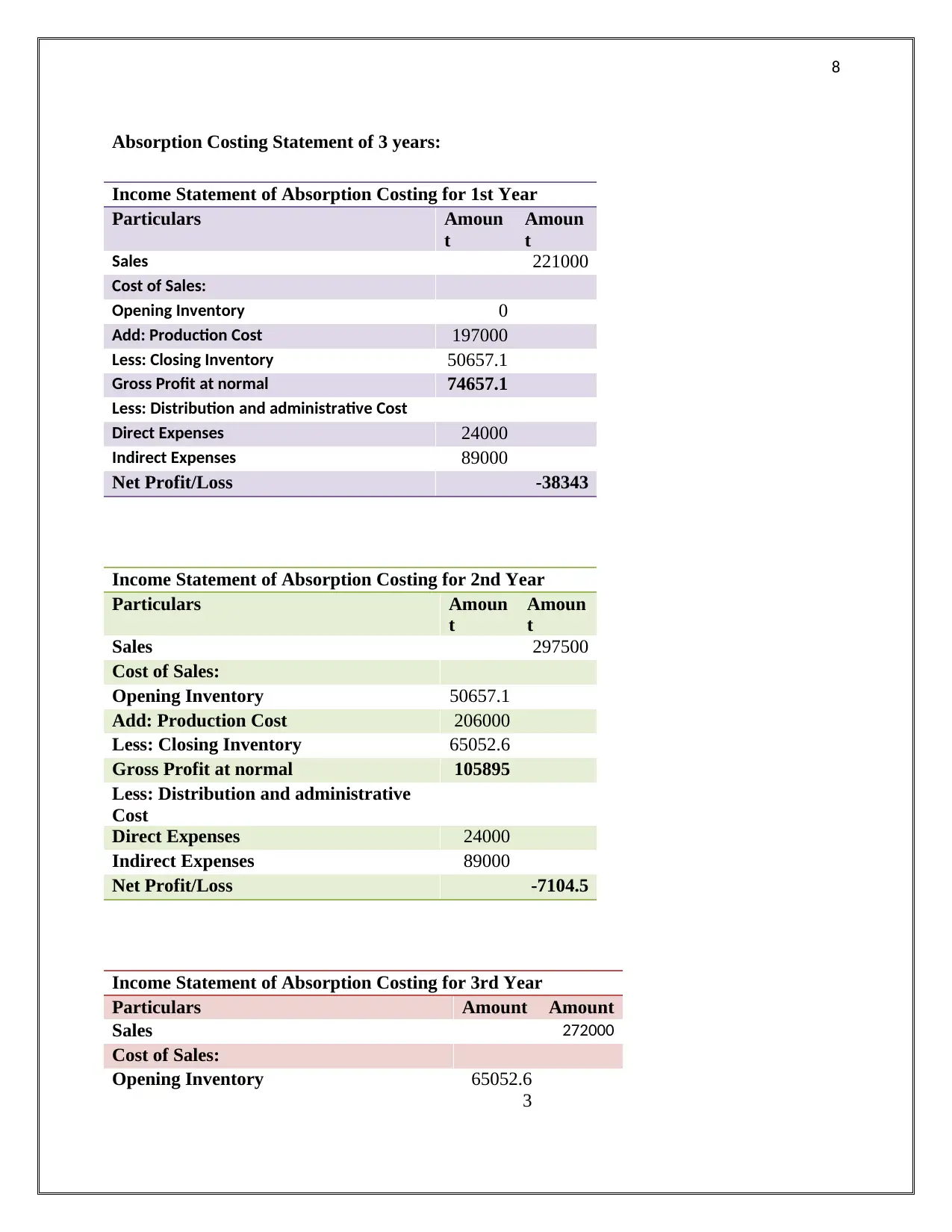
8
Absorption Costing Statement of 3 years:
Income Statement of Absorption Costing for 1st Year
Particulars Amoun
t
Amoun
t
Sales 221000
Cost of Sales:
Opening Inventory 0
Add: Production Cost 197000
Less: Closing Inventory 50657.1
Gross Profit at normal 74657.1
Less: Distribution and administrative Cost
Direct Expenses 24000
Indirect Expenses 89000
Net Profit/Loss -38343
Income Statement of Absorption Costing for 2nd Year
Particulars Amoun
t
Amoun
t
Sales 297500
Cost of Sales:
Opening Inventory 50657.1
Add: Production Cost 206000
Less: Closing Inventory 65052.6
Gross Profit at normal 105895
Less: Distribution and administrative
Cost
Direct Expenses 24000
Indirect Expenses 89000
Net Profit/Loss -7104.5
Income Statement of Absorption Costing for 3rd Year
Particulars Amount Amount
Sales 272000
Cost of Sales:
Opening Inventory 65052.6
3
Absorption Costing Statement of 3 years:
Income Statement of Absorption Costing for 1st Year
Particulars Amoun
t
Amoun
t
Sales 221000
Cost of Sales:
Opening Inventory 0
Add: Production Cost 197000
Less: Closing Inventory 50657.1
Gross Profit at normal 74657.1
Less: Distribution and administrative Cost
Direct Expenses 24000
Indirect Expenses 89000
Net Profit/Loss -38343
Income Statement of Absorption Costing for 2nd Year
Particulars Amoun
t
Amoun
t
Sales 297500
Cost of Sales:
Opening Inventory 50657.1
Add: Production Cost 206000
Less: Closing Inventory 65052.6
Gross Profit at normal 105895
Less: Distribution and administrative
Cost
Direct Expenses 24000
Indirect Expenses 89000
Net Profit/Loss -7104.5
Income Statement of Absorption Costing for 3rd Year
Particulars Amount Amount
Sales 272000
Cost of Sales:
Opening Inventory 65052.6
3
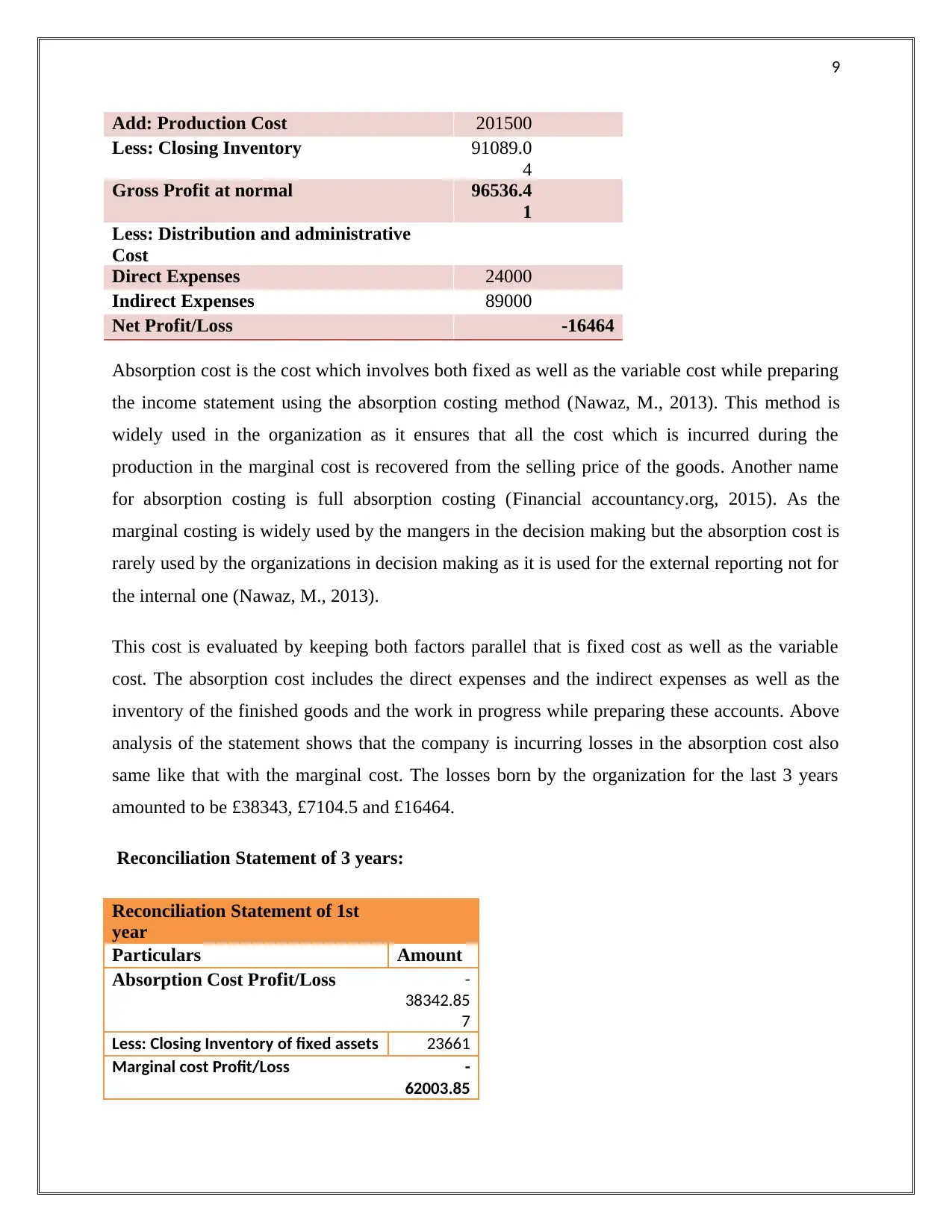
9
Add: Production Cost 201500
Less: Closing Inventory 91089.0
4
Gross Profit at normal 96536.4
1
Less: Distribution and administrative
Cost
Direct Expenses 24000
Indirect Expenses 89000
Net Profit/Loss -16464
Absorption cost is the cost which involves both fixed as well as the variable cost while preparing
the income statement using the absorption costing method (Nawaz, M., 2013). This method is
widely used in the organization as it ensures that all the cost which is incurred during the
production in the marginal cost is recovered from the selling price of the goods. Another name
for absorption costing is full absorption costing (Financial accountancy.org, 2015). As the
marginal costing is widely used by the mangers in the decision making but the absorption cost is
rarely used by the organizations in decision making as it is used for the external reporting not for
the internal one (Nawaz, M., 2013).
This cost is evaluated by keeping both factors parallel that is fixed cost as well as the variable
cost. The absorption cost includes the direct expenses and the indirect expenses as well as the
inventory of the finished goods and the work in progress while preparing these accounts. Above
analysis of the statement shows that the company is incurring losses in the absorption cost also
same like that with the marginal cost. The losses born by the organization for the last 3 years
amounted to be £38343, £7104.5 and £16464.
Reconciliation Statement of 3 years:
Reconciliation Statement of 1st
year
Particulars Amount
Absorption Cost Profit/Loss -
38342.85
7
Less: Closing Inventory of fixed assets 23661
Marginal cost Profit/Loss -
62003.85
Add: Production Cost 201500
Less: Closing Inventory 91089.0
4
Gross Profit at normal 96536.4
1
Less: Distribution and administrative
Cost
Direct Expenses 24000
Indirect Expenses 89000
Net Profit/Loss -16464
Absorption cost is the cost which involves both fixed as well as the variable cost while preparing
the income statement using the absorption costing method (Nawaz, M., 2013). This method is
widely used in the organization as it ensures that all the cost which is incurred during the
production in the marginal cost is recovered from the selling price of the goods. Another name
for absorption costing is full absorption costing (Financial accountancy.org, 2015). As the
marginal costing is widely used by the mangers in the decision making but the absorption cost is
rarely used by the organizations in decision making as it is used for the external reporting not for
the internal one (Nawaz, M., 2013).
This cost is evaluated by keeping both factors parallel that is fixed cost as well as the variable
cost. The absorption cost includes the direct expenses and the indirect expenses as well as the
inventory of the finished goods and the work in progress while preparing these accounts. Above
analysis of the statement shows that the company is incurring losses in the absorption cost also
same like that with the marginal cost. The losses born by the organization for the last 3 years
amounted to be £38343, £7104.5 and £16464.
Reconciliation Statement of 3 years:
Reconciliation Statement of 1st
year
Particulars Amount
Absorption Cost Profit/Loss -
38342.85
7
Less: Closing Inventory of fixed assets 23661
Marginal cost Profit/Loss -
62003.85
⊘ This is a preview!⊘
Do you want full access?
Subscribe today to unlock all pages.

Trusted by 1+ million students worldwide
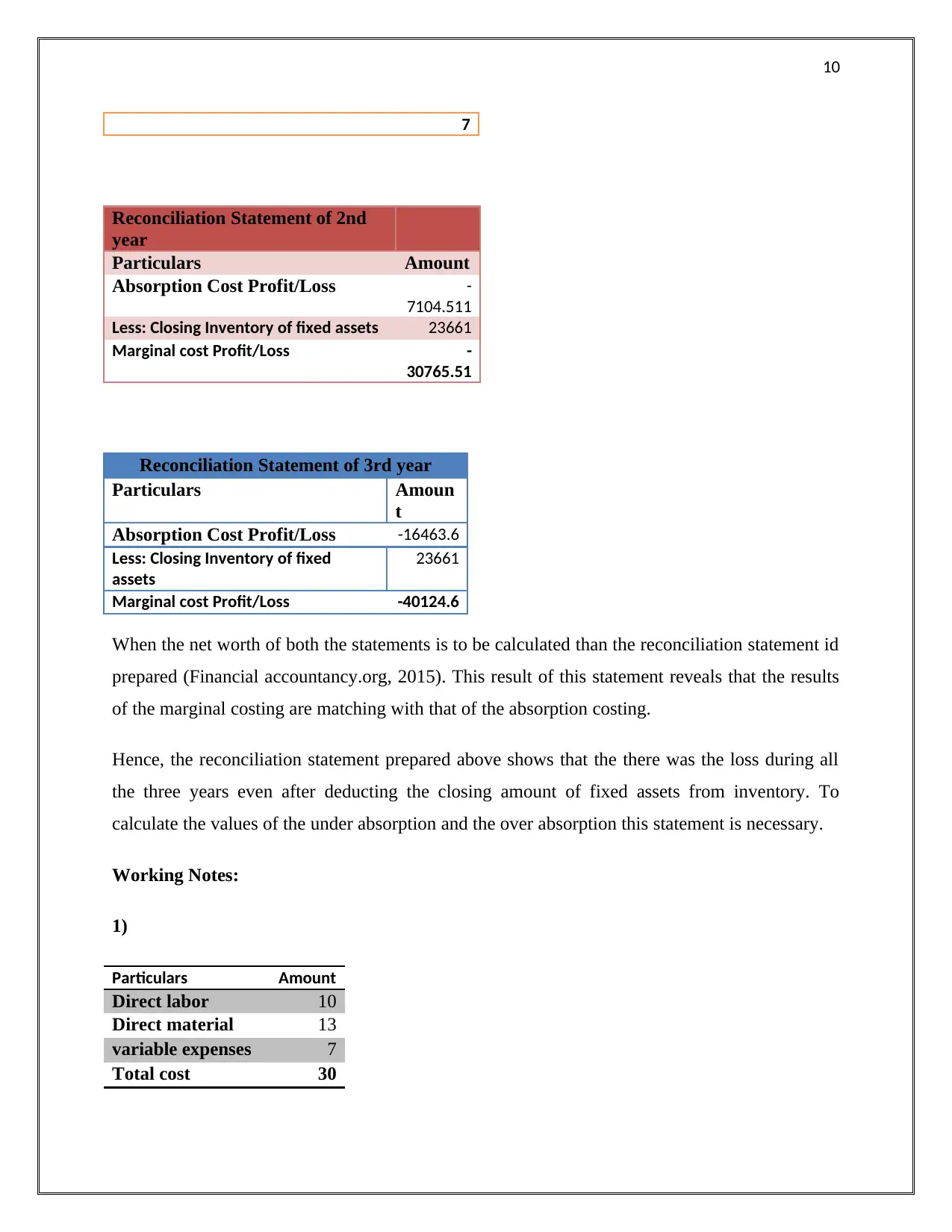
10
7
Reconciliation Statement of 2nd
year
Particulars Amount
Absorption Cost Profit/Loss -
7104.511
Less: Closing Inventory of fixed assets 23661
Marginal cost Profit/Loss -
30765.51
Reconciliation Statement of 3rd year
Particulars Amoun
t
Absorption Cost Profit/Loss -16463.6
Less: Closing Inventory of fixed
assets
23661
Marginal cost Profit/Loss -40124.6
When the net worth of both the statements is to be calculated than the reconciliation statement id
prepared (Financial accountancy.org, 2015). This result of this statement reveals that the results
of the marginal costing are matching with that of the absorption costing.
Hence, the reconciliation statement prepared above shows that the there was the loss during all
the three years even after deducting the closing amount of fixed assets from inventory. To
calculate the values of the under absorption and the over absorption this statement is necessary.
Working Notes:
1)
Particulars Amount
Direct labor 10
Direct material 13
variable expenses 7
Total cost 30
7
Reconciliation Statement of 2nd
year
Particulars Amount
Absorption Cost Profit/Loss -
7104.511
Less: Closing Inventory of fixed assets 23661
Marginal cost Profit/Loss -
30765.51
Reconciliation Statement of 3rd year
Particulars Amoun
t
Absorption Cost Profit/Loss -16463.6
Less: Closing Inventory of fixed
assets
23661
Marginal cost Profit/Loss -40124.6
When the net worth of both the statements is to be calculated than the reconciliation statement id
prepared (Financial accountancy.org, 2015). This result of this statement reveals that the results
of the marginal costing are matching with that of the absorption costing.
Hence, the reconciliation statement prepared above shows that the there was the loss during all
the three years even after deducting the closing amount of fixed assets from inventory. To
calculate the values of the under absorption and the over absorption this statement is necessary.
Working Notes:
1)
Particulars Amount
Direct labor 10
Direct material 13
variable expenses 7
Total cost 30
Paraphrase This Document
Need a fresh take? Get an instant paraphrase of this document with our AI Paraphraser
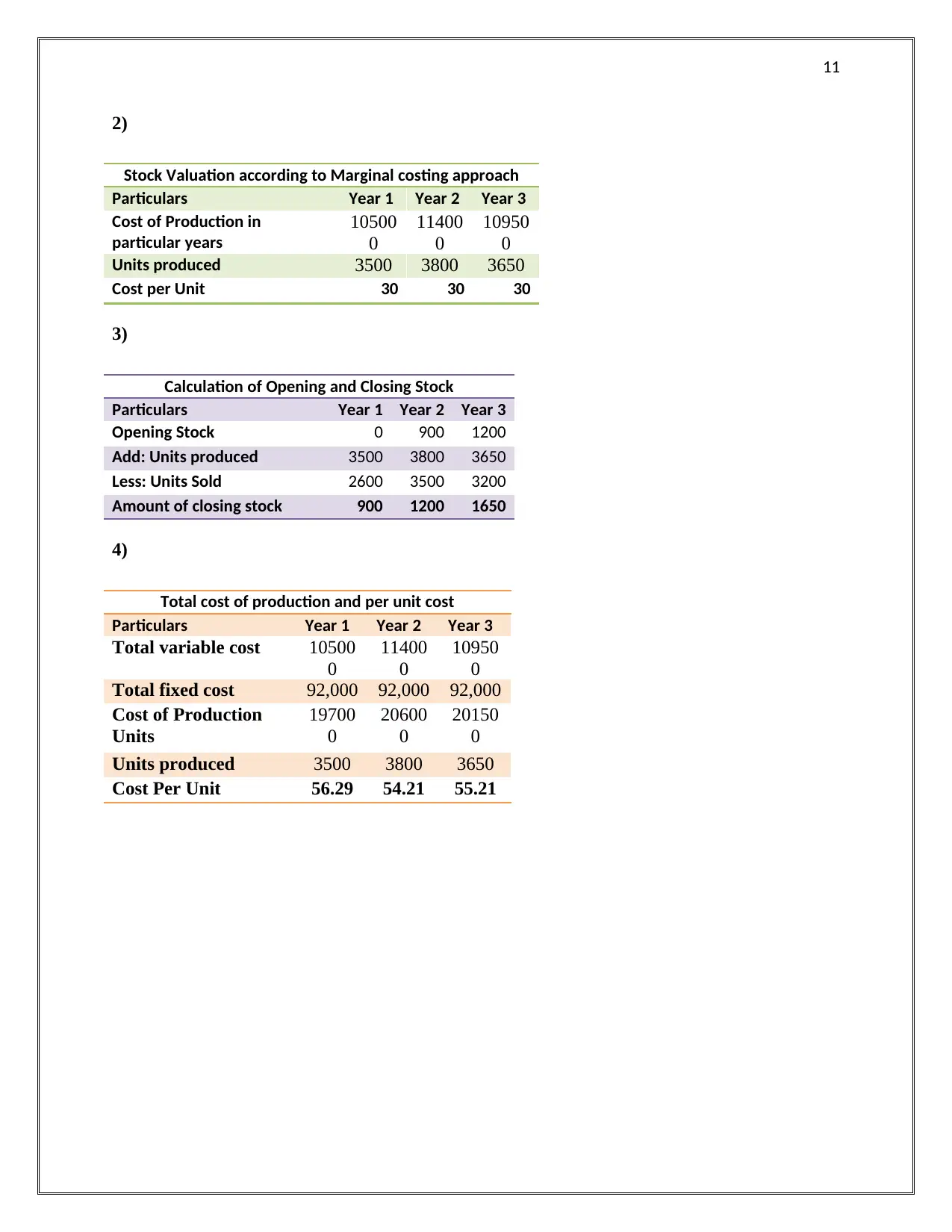
11
2)
Stock Valuation according to Marginal costing approach
Particulars Year 1 Year 2 Year 3
Cost of Production in
particular years
10500
0
11400
0
10950
0
Units produced 3500 3800 3650
Cost per Unit 30 30 30
3)
Calculation of Opening and Closing Stock
Particulars Year 1 Year 2 Year 3
Opening Stock 0 900 1200
Add: Units produced 3500 3800 3650
Less: Units Sold 2600 3500 3200
Amount of closing stock 900 1200 1650
4)
Total cost of production and per unit cost
Particulars Year 1 Year 2 Year 3
Total variable cost 10500
0
11400
0
10950
0
Total fixed cost 92,000 92,000 92,000
Cost of Production
Units
19700
0
20600
0
20150
0
Units produced 3500 3800 3650
Cost Per Unit 56.29 54.21 55.21
2)
Stock Valuation according to Marginal costing approach
Particulars Year 1 Year 2 Year 3
Cost of Production in
particular years
10500
0
11400
0
10950
0
Units produced 3500 3800 3650
Cost per Unit 30 30 30
3)
Calculation of Opening and Closing Stock
Particulars Year 1 Year 2 Year 3
Opening Stock 0 900 1200
Add: Units produced 3500 3800 3650
Less: Units Sold 2600 3500 3200
Amount of closing stock 900 1200 1650
4)
Total cost of production and per unit cost
Particulars Year 1 Year 2 Year 3
Total variable cost 10500
0
11400
0
10950
0
Total fixed cost 92,000 92,000 92,000
Cost of Production
Units
19700
0
20600
0
20150
0
Units produced 3500 3800 3650
Cost Per Unit 56.29 54.21 55.21
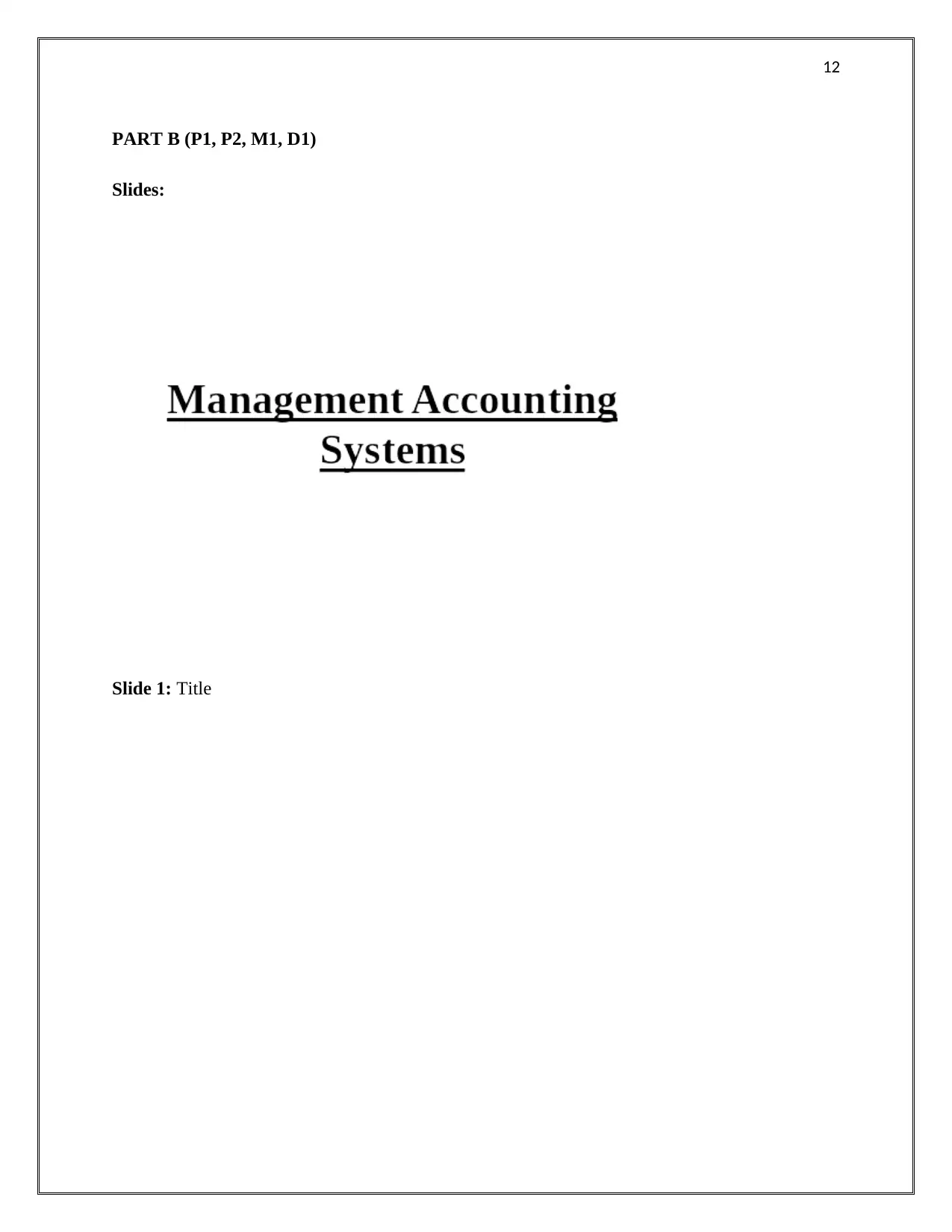
12
PART B (P1, P2, M1, D1)
Slides:
Slide 1: Title
PART B (P1, P2, M1, D1)
Slides:
Slide 1: Title
⊘ This is a preview!⊘
Do you want full access?
Subscribe today to unlock all pages.

Trusted by 1+ million students worldwide
1 out of 35
Related Documents
Your All-in-One AI-Powered Toolkit for Academic Success.
+13062052269
info@desklib.com
Available 24*7 on WhatsApp / Email
![[object Object]](/_next/static/media/star-bottom.7253800d.svg)
Unlock your academic potential
Copyright © 2020–2025 A2Z Services. All Rights Reserved. Developed and managed by ZUCOL.





